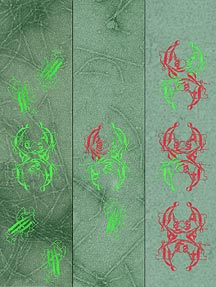TSRI Scientists Discover a Therapeutic Strategy for "Misfolding Diseases"
Analogous to Alzheimer's Disease
By Jason Socrates Bardi
Investigator Jeffery W. Kelly and his colleagues in the Department of
Chemistry and The Skaggs Institute for Chemical Biology at The Scripps
Research Institute (TSRI) have uncovered a potentially useful strategy
to treat the rare disease familial amyloid polyneuropathy (FAP)—an
approach that may be generally useful for intervention in other amyloid
diseases.
In the current issue of the journal Science, the team demonstrates
that it is possible to prevent the protein shape changes that cause FAP,
a disease that is analogous to Alzheimer's. The strategy is to introduce
another protein that interacts with the protein capable of aberrant shape
changes, preventing them.
"I'm very excited about pursuing these potential therapeutic opportunities,"
says Kelly.
Amyloid-forming diseases like FAP are generally characterized by the
formation of microscopic fibrils made up of hundreds of misfolded proteins
that cluster together and deposit in organs, interfering with their normal
function.
FAP, a rare amyloid disease, is caused by the misfolding of the protein
transthyretin (TTR), which is secreted by the liver into the bloodstream
to carry thyroid hormone and vitamin A. Normally, TTR circulates in the
blood as an active "tetramer" made up of four separate copies, or protein
subunits, that bind to each other.
These subunits come from two different genes on two different chromosomes.
The resulting tetramers are composed of identical protein subunits when
the genes are identical.
However, when one of the copies has a heritable defect, hybrid tetramers
form that are composed of mutant and normal subunits. The inclusion of
mutated subunits makes the tetramer less stable and causes the four subunits
to dissociate under conditions where they are not supposed to. Once the
subunits are free, they can misfold and reassemble into the hair-like
amyloid fibrils.
These fibrils cause the disease FAP by building up around peripheral
nerve and muscle tissue, disrupting their function and leading to numbness
and muscle weakness, and—in advanced cases—failure of the gastrointestinal
tract. The current treatment for FAP is a liver transplant, which replaces
the mutant gene with a normal copy.
Kelly and his colleagues discovered that a "suppressor" TTR subunit
incorporated into a TTR tetramer with disease-associated destabilizing
subunits prevents the tetramer from dissociating into potential fibril-forming
monomers. Significantly, they found that incorporating even one of the
suppressor subunit into a tetramer where the remainder of the subunits
have disease-associated mutations doubles its stability. "The suppressor
protein subunits prevent misfolding by preventing dissociation," says
Kelly.
This "trans" suppression approach may form the basis for a new therapy
for FAP, in which a patient could receive an injection of the suppressor
protein. The idea may also work with other diseases where the protein
normally engages in protein-protein interactions. When gene therapy becomes
practical, one may be able to introduce the suppressor gene directly into
the organ that makes the aberrant protein. The protective subunit will
therefore be incorporated during biosynthesis, thus preventing later misfolding.
The research article, "Trans-Suppression of Misfolding in an
Amyloid Disease" is authored by Per Hammarstrom, Frank Schneider, and
Jeffery W. Kelly and appears in the September 28, 2001 issue of the journal
Science.
The research was funded in part by the National Institutes of Health,
The Skaggs Institute for Chemical Biology and the Lita Annenberg Hazen
Foundation.
Go back to News & Views Index
|

Jeffery Kelly is Lita Annenberg Hazen Professor
of Chemistry, vice president of academic affairs, and dean of graduate
studies. Photo by Michael Balderas.

Trans-Suppression of Misfolding: A transthyretin
tetramer composed exclusively of disease-associated V30M mutant monomers
(green subunits in left panel) readily dissociates and misfolds causing
amyloid fibril formation (background micrograph in left panel). Kelly
and coworkers find that incorporating one T119M suppressor monomer (red
subunit in the tetramer, center panel) reduces fibril formation two-fold.
Incorporating additional T119M suppressor subunits (right panel) stops
tetramer dissociation completely and prevents transthyretin misfolding,
thus inhibiting fibril formation.
|



